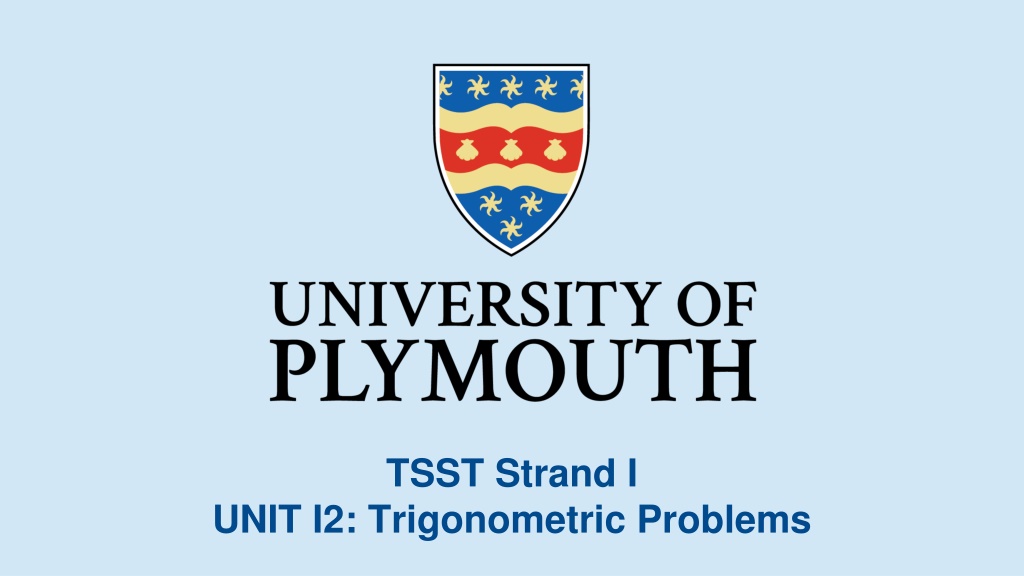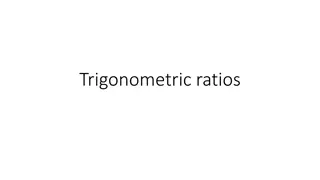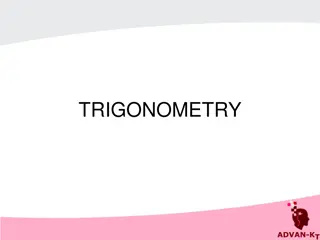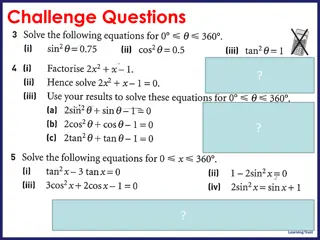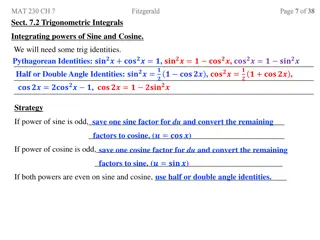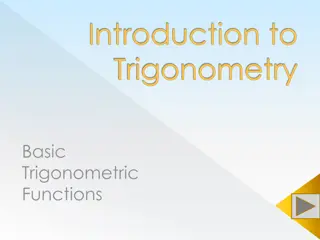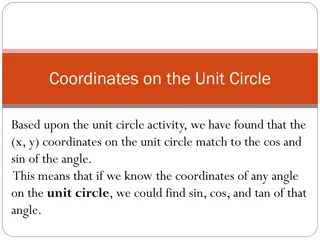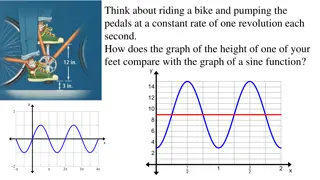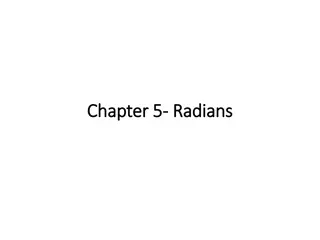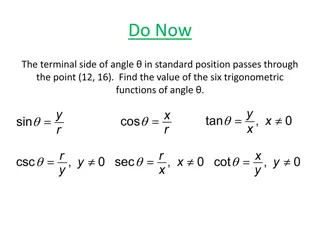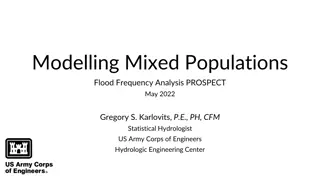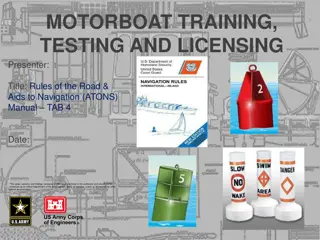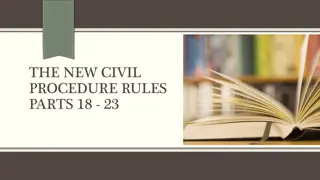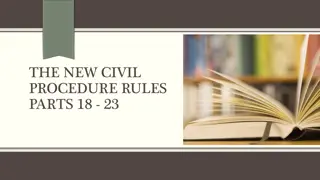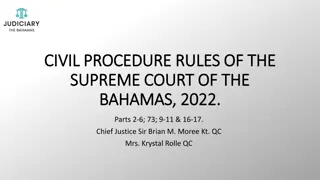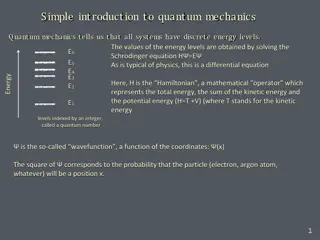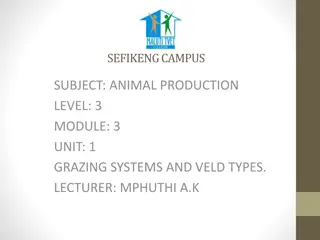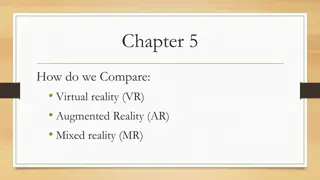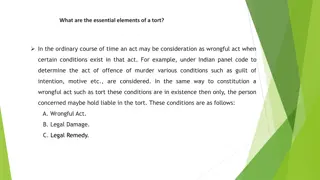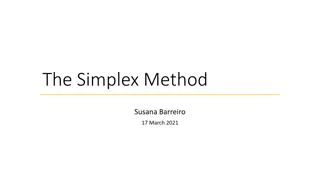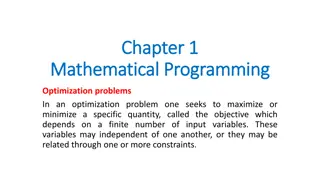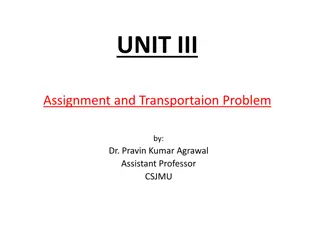Trigonometric Problems: Mixed, Sine and Cosine Rules
This strand delves into trigonometric problems focusing on triangles with mixed information, exploring side lengths and angle measurements beyond right-angled triangles. It covers mixed problems, sine and cosine rules, applying area of any triangle, and Heron's formula. Engage in various exercises including calculations and angle determinations to strengthen your trigonometry skills.
Download Presentation

Please find below an Image/Link to download the presentation.
The content on the website is provided AS IS for your information and personal use only. It may not be sold, licensed, or shared on other websites without obtaining consent from the author. Download presentation by click this link. If you encounter any issues during the download, it is possible that the publisher has removed the file from their server.
E N D
Presentation Transcript
TSST Strand I UNIT I2: Trigonometric Problems
Trigonometric Problems Strand I Unit I2 This units looks at problems where we are given less information about triangles and moves on to look at finding the lengths of sides and size of angles in any triangle (not just right-angled triangles). You have four sections to work through and there are check up audits and fitness tests for each section 1. Mixed Problems using Trigonometry 2. Sine and Cosine Rules 3. Application: Area of Any Triangle 4. Heron's Formula
Mixed Problems using Trigonometry Strand I Unit I2 Section I2.1 Example ABC is a right angled triangle. AB is of length 4 m and BC is of length 13 m. a) Calculate the length of AC. b) Calculate the size of angle ABC. Solution a) Length AC: Given two sides, the adjacent = 4 m, hypotenuse = 13 m We use Pythagoras to find AC: ?2 = ?2+ ?2 ?2 = 132+ 42 ?2 = 169 + 16 = 185 giving ? = 185 = 13.6 to 1.d.p. cos = b) Angle ABC: ???????? ?????????= 4 13 = ??? 1 (4 = 72.1 to 1 d.p. 13)
Section I2.1: Fitness Check Strand I Unit I2 Section I2.1 Here is a question to check your progress. The diagram shows a roofing frame ABCD. AB =7 m, BC=5 m, and angle ABD = angle DBC = 90 a) Calculate the length of AD. b) Calculate the size of angle DCB. Answers a)7.62 (2 d.p.) b) 31 (1 d.p.)
Section I2.1: Review STRAND I Unit I2 Section I2.1 You have completed the first Section. If you have completed and understood this section, click to start the next Section. If you need more examples and interactive practice, go to http://szalonta.hu/ske/text/I2/skei2s1.html
Sine and Cosine Rules STRAND I Unit I2 Section I2.2 The sine and cosine rules are used to find a side or an angle in a triangle. In the triangle ABC, the side opposite angle A has length a, the side opposite angle B has length b and the side opposite angle C has length c. The cosine rule states ?2= ?2+ ?2 2?? cos A ?2= ?2+ ?2 2?? cos B c2= ?2+ ?2 2?? cos C The sine rule states sinA ? =sin B =sinC ? ? Note that when, for example A = 900, the formula becomes, as expected, Pythagoras Theorem: ?2= ?2+ ?2
Sine and Cosine Rules STRAND I Unit I2 Section I2.2 The cosine rule can be used in any triangle to calculate: a side when two sides and the angle in between them are known (SAS) an angle when three sides are known (SSS) The sine rule can be used in any triangle to calculate: a side when two angles and an opposite side are known (AAS) an angle when two sides and an opposite angle are known (SSA)
Sine Rule STRAND I Unit I2 Section I2.2 Example 1 Find the unknown angles and side length of the triangle shown. Solution Using the sine rule sin A 2.1=sin70 =sin B Since angles in a triangle add up to 180 B = 180 70 34.32 75.68 3.5 ? From the first equality, ?in70 3.5 =sin B From the sine rule b = 3.5 sin B sin A = 2.1 sin 70 ? 0.5638 3.5 3.5 sin 75.68 sin 70 sin 70 = 3.61 cm A 34.32
Sine Rule STRAND I Unit I2 Section I2.2 Example 2 Find two solutions for the unknown angles and side of the triangle shown. Solution Using the sine rule: sin A =sinB =sin C ? ? ? From the second equality sin B = 6 sin 42 0.8030 5 A graph shows that there are two solutions for B between 0 and 180 Solution continues on next slide
STRAND I Unit I2 Section I2.2 Sine Rule Solution (continued) These solutions are B = 53.41 and by symmetry B = 180 53.41 = 126.59 Solving for A we have A = 180 42 B and when B = 53.41 , then A = 84.59 When B = 126.59 , then A = 11.41 a=6 sinA sin B From the sine rule For A = 84.59 , B = 53.41 and a = 7.44 cm. For A = 11.41 , B = 126.59 and a = 1.48 cm; but you can easily see that this answer does not fit with the diagram. Solution Looking at the diagram above a = 7.44 cm
Cosine and Sine Rules STRAND I Unit I2 Section I2.2 Example Find the unknown side and angles of the triangle shown. Solution To find a, use the cosine rule ?2= ?2+ ?2 2?? cos ? ?2 = 4.92+ 3.72 2 4.9 3.7 cos65 ?2= 22.3759 ?= 4.73 (to 2 d.p.) To find the angles, use the sine rule: sin C 3.7=sin 65 ? 4.9 sin B = 4.9 sin 65 ? giving B = 69.86 =sin B Therefore A = 65 B = 69.86 C = 180 65 69.86 = 45.14 = 4.9 sin 65 4.73 = 0.9389
STRAND I Unit I2 Section I2.2 sin , cos and tan Some key values of sin ? , cos ? and tan ? are shown below. The graphs of sin ? and cos ? for any angle are shown below. ? sin ? cos ? tan ? 0 0 1 0 30 2 1 3 1 2 3 1 1 45 2 1 2 3 1 2 60 3 2 90 1 0 infinite The graphs are examples of periodic functions. The graph repeats every 360 . (The period is 360 )
Sine and Cosine Rules STRAND I Unit I2 Section I2.2 Example An oil tanker leaves Town X, and travels on a bearing of 050 to Town Z, 50 km away. The tanker then travels to Town Y, 70 km away, on a bearing of 120 . a) Find the distance of Y from X, giving your answer to 3 sig. figs. Solution a) In triangle XZY, angle XZY = 50 + 60 =110 so, using the cosine rule XY2 = 502 + 702 2 50 70 cos 110 = 2500 + 4900 7000 cos 110 7400 7000 ( 0.3420) = 9794 XY 98.965= 99.0 to 3 sig. figs.
Sine and Cosine Rules STRAND I Unit I2 Section I2.2 Example (continued) b) Calculate the bearing of X from Y, giving your answer to the nearest degree Solution We need to find the angle ZYX to determine the bearing of X from Y. In triangle ZYX, using the sine rule, sinZYX 50 =sin 110 99 So sin ZYX 0.4748 giving angle ZYX 28.34 = 28 to the nearest degree Hence the bearing of X from Y = 360 ( 60 + 28 ) = 272
Sine and Cosine Rules STRAND I Unit I2 Section I2.2 Example Find the shaded angle in the triangle shown, giving your answer to one decimal place. Solution Using the cosine rule, 252 = 162 + 132 2 16 13 cos x Rearranging: 2 16 13 cos x = 162 + 132 252 416 cos x= 200 So cos x = 25 52 and using the SHIFT and COS buttons on a calculator: x= cos 1( 25 52) = 118.7 (to 1decimal place)
STRAND I Unit I2 Section I2.2 Section I2.2: Fitness Check Here are some questions to check your progress 1. a) Find the unknown angle marked ?. Answer sin? 8.1 =sin85 10.3 giving ? = 51.6 (1 d.p.) b) Find the unknown side marked a. Answer sin60 5 =sin70 givinga = 5.43 9 (2 d.p.) ?
STRAND I Unit I2 Section I2.2 Section I2.2: Fitness Check Here are some questions to check your progress 3. Find the unknown angles and sides. Answers a = 3.278 cm, C = 67.6 (1 d.p.), B = 52.4 (1 d.p.) 4. To calculate the height of a church tower, a surveyor measures the angle of elevation of the top of the tower from two points 50 m apart. a) Calculate the distance BC. b) Hence calculate the height CD. a) 24.12 m b) 32.98 m Answers
Section I2.2: Review STRAND I Unit I2 Section I2.2 You have completed the second Section. If you have completed and understood this section, click to start the next Section. If you need more examples and interactive practice, go to http://szalonta.hu/ske/text/I2/skei2s2.html
STRAND I Unit I2 Section I2.3 Application: Area of any Triangle An important application of trigonometry is that of finding the area of a triangle with side lengths a and b and included angle ?. This area, A, is given by We can prove this result by constructing the perpendicular line from point B to the line AC. Area = 1 = 1 where p = a sin? 2 base perpendicular height 2 ? ? So Area = 1 1 2 ??sin? 2 ? a sin?=
STRAND I Unit I2 Section I2.3 Application: Area of any Triangle Example The diagram shows a circle of radius 64 cm. The length of the chord AB is 100 cm. a) Find the angle ?, to 2 decimal places, b) Find the area of triangle OAB. Solution a) sin?=50 Giving ?= 51.38 64 b) A =1 1997 cm2 2ab sin? =1 2 64 64 sin 102.76
STRAND I Unit I2 Section I2.3 Application: Area of any Triangle Example 3 Given that sin ? = a) the area of triangle CDE where CD = 30 units and DE = 20 units; b) the length CE. Solution 2 , 0 ? 90 ,find a) Area =1 b) We first find the angle ?: 3 2 Now we use the cosine rule to find the length CE 2a b sin ? =1 3 2 = 150 3 cm2 2 30 20 3 sin ? 1( ? = 60 sin ? = 2) ??2 = 302+ 202 2 30 20 cos 60 ??2 = 900+400 1200 cos 60 ??2= 700 ?? = 700 ?? = 26.46 2 d.p.
STRAND I Unit I2 Section I2.3 Section I2.3: Fitness Check Here are some questions to check your progress 1. Find the area of the shaded region. Give your answer to 2 decimal places. 24.13 cm2 Answer 2. Find the area of the shaded region. Give your answer to 2 decimal places 94.53 cm2 Answer
STRAND I Unit I2 Section I2.3 Section I2.3: Fitness Check Here are some questions to check your progress 3. In the diagram ST = 5 cm, TW = 9 cm and STW = 52 . Calculate, giving answers to 2 decimal places: a) the length of SW; b) the area of triangle STW. Answers b) Area = 17.73 cm2 a) ?? = 7.11 cm
Section I2.3: Review STRAND I Unit I2 Section I2.3 You have completed the third Section. If you have completed and understood this section, click to start the next Section. If you need more examples and interactive practice, go to http://szalonta.hu/ske/text/I2/skei2s3.html
STRAND I Unit I2 Section I2.4 Heron s Formula You have already met the formula for the area of a triangle when the lengths of two sides and the included angle are known: Area =1 2absin C There is another formula for the area of a triangle when all 3 sides are given. This is credited to Heron (or Hero) of Alexandria; a proof can be found in his book, Metrica, written in about AD 60. The formula, known as Heron's formula, is given by where ? = ?+?+? Area = ?(? ?)(? ?)(? ?) 2
STRAND I Unit I2 Section I2.4 Heron s Formula Example For the triangle shown, find a) the area of the triangle, b) angle . Solution a) Using Heron's formula ? = 4+5+7 where ? = ?+?+? Area = ?(? ?)(? ?)(? ?) = 8 gives 2 2 Hence area = = 9.80cm2 to 2 d.p. 8(8 4)(8 7)(8 5) b) To find angle ?, we use ? =1 2ab sin ? 9.80=1 ? = 78.5 to 1 d.p. sin ? = 0.98 2 4 5 sin ?
STRAND I Unit I2 Section I2.4 Section I2.4: Fitness Check Here are some questions to check your progress 1. Calculate this area of the triangle. Area= 12 cm2 Answer 2. Find: a) the area of the triangle opposite, b) the angle shown by ?. a) Area = 27.81 mm2 b) ? = 44 Answers
Section I1.4: Review STRAND I Unit I1 Section I1.4 You have completed the last Section. If you need more examples and interactive practice, go to http://szalonta.hu/ske/text/I2/skei2s4.html
